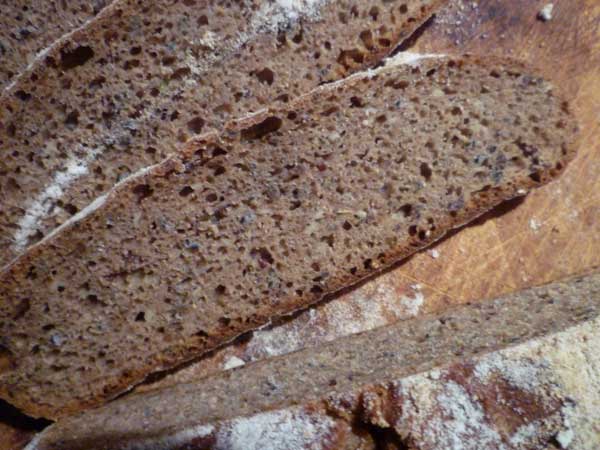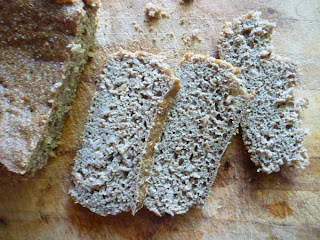Some Tartine Style Loaves
I made 4 Tartine-style loaves today. I fiddled with the ingredients. Nothing fancy, mind you.
One was for my sweetie (and the other from that batch I am giving to a nurse who worked a shift for me while I was away camping, with thanks, along with some of the jam we made from wild blueberries and chokecherries. I rarely give away bread to co-workers, in fact this may be the first time I've done it. Most girls think -- erroneously, I believe -- that bread aka carbs is fattening. Well, it depends upon the bread. In this case, probably the jam is more fattening). These two loaves contain some AP flour (though not quite the amount in Tartine's Country Loaf). This was 50-40-10, percentages for AP, WW and Rye flours.
The other two loaves were for me, since I am working nights all weekend and won't be able to bake; I'll be taking sandwiches to work. They are made with 83% whole wheat, and 17% rye flour; the starter was 100% whole wheat. I also included about 250g of soaked rye berries.
All dough was retarded in the refrigerator from 0330 until I baked them the following day -- I started preheating the oven when I awoke at 0700. When the loaves are finished, and the blogging done, I took another daytime nap.
Results:
I had some of the whole wheat batch, the one with soaked rye berries. It is extremely moist. It is the berries that do this, and they are flavourful because they've been soaked a long time in our homemade crabapple juice. The bread is baked well enough, but it is so moist it feels as if it is a bread that has taken on some humidity. My concern for this loaf is not that it will stale, but rather that it will spoil. While perfectly acceptable for sandwiches, this bread is going to be better toasted.
I'll try to get a shot of my sweetie's loaf if and when she ever cuts into it.
Random Thoughts that -- Trust me -- will eventually Circle Back to Bread
I miss my friend Dave, who died of the complications of his drinking addiction several years ago. We used to work together, and we had a lot of laughs before he began to really go downhill. Eventually he succumbed to Korsakoff's Syndrome, and the laughs got fewer. I tried to get him to quit drinking, but unlike many of his friends and family who had given him an ultimatum, I didn't put our friendship on the scale against the booze. I had seen how that would go. He had no one left but me and his mother.
His gait was unsteady as we walked down the street from our hotel room to go to a restaurant, so I reached out my hand to hold him. We walked slowly down the street arm in arm. Just then, a carload of university boys drove by and one leaned out the window and yelled, "Fags!" Dave turned to me and said, "You know I love you, right? Just not that way." We laughed our asses off. I told him to "Fuck off" and he told me to "Fuck off" and we both said it with a smile.
I really miss having a friend who can tell you to "Fuck off" with a smile.
----
One of the most interesting books that I've read recently is
William Powers "Twelve by Twelve: A One-Room Cabin off the Grid & Beyond the American Dream". I took it with me on vacation. Now, a couple of weeks later, something in the book still haunts me. But before I say what, let me tell you of a predicament I'm in:
---
I am expected to attend a party with several of my co-workers. One of the nurses I work with on the hospital Palliative Care Unit has been off work for awhile now and has just given birth to her first child. All the nurses from our floor who can make it are invited to a meet-and-greet home party to finally see the newborn.
I feel I have a special connection to the baby's mother, as I was her preceptor when she consolidated and became a nurse a few years back. Although the student-preceptor relationship is only about 4-5 months long, it is very intense, and despite our age differences I became rather fond of her. I knew that after teaching her and watching her develop into a fully independent nurse, we would never again be as close. But my interest in her and her career will never end.
In short, I would love to see her and the baby, even though I will be the only man, and quite likely a bit uncomfortable in a party that is essentially a baby-shower. This, however, is nothing new: in many of my life situations - working as a nurse, exercising with yoga, baking bread - I am often the only man for miles. I suspect no one will notice how ill-at-ease I will feel. My co-workers are all wonderful, amazing people, and they have always made me feel like one of the girls, which is the best compliment that I can imagine. (Well, perhaps being called a fag is slightly higher on the list of compliments too).
I had wanted to share with the new mother something that Powers had written, that has stayed with me, perhaps in a card attached to a gift. But now I'm not so sure that the deeply moving passage is totally appropriate, even for a young mother who has looked death in the face countless times while working extensively in Palliative Care.
Recalling the birth of his own daughter, with whom he no longer lives,
Powers wrote:
The first time I held her, she was the length of my forearm. Her mother's ecstatic smile over this perfect form that's come out of her, laced with the courage of giving birth to someone she knows will someday die. Kathleen Norris captured this:
her water breaking,
her crying out,
the downward draw of blood and bone….
Now the new mother, that leaky vessel,
begins to nurse her child,
beginning the long goodbye.
---
Now, as I ponder whether or not to put this poem in a card to my friend and coworker, I am thinking also of yet another friend whom I have not seen in a long time. When I first met him, he assumed he would be dead soon of AIDS, or liver cancer; but with modern medicines, neither his HIV nor cancer has progressed, and he is tasked again with living. When I first met him, too, he was grieving over the death of his spouse, who had recently taken his own life without leaving a note.
In our frequent meetings, the first year after the suicide, my friend eventually opened up to me and offered the only explanation he could about why his best friend, lover and husband would have taken his own life. Despite his husband's bouts of depression, he had had a stable relationship, he knew he was well-loved, he had meaningful employment, and he had hopes and goals for life, including the adoption of a child. Why would he climb to the top of the local grain elevator in the middle of the night in a snowstorm and dive off head-first? Why would he deliberately kill himself without so much as a note of explanation?
"I'll never know why he did it," my friend told me. "but I think it was his way of saying 'Fuck you!' to God."
I am thinking how taking one's life is a courageous act, but it is far more courageous to go on living in spite of death's inevitability. How courageous it is to go on loving, knowing that those you love will one day be dead, and your heart will be broken forever.
I am thinking that giving birth is yet another way to say 'Fuck you' to God.
It's all in how you say it. The 'Fuck you' that I refer to is akin to worship. It is the "Fuck you" said with a smile to a Best Friend. Every moment of every day can be a similar worship of the Divine, a holy "Fuck you!'
And all thoughts lead back to bread in a long segue in this blog.
Bread: it is among the cheapest of our foodstuffs, if you are undiscriminating when you buy it. If you make it yourself, depending on how you do it, it can be among the cheapest or the most expensive of foods -- in terms of time, and ingredients, and the expertise required to do it right, there is definitely a cost to doing it yourself. Even today, people around the world make their own bread out of necessity, for sustenance. And others, like me perhaps, do it as an artisan-like hobby.
To say "no" to the cheapest wonderloaf is to be somewhat counter-cultural. To say "no" to the white-bread, Chorleywood dough-extruded, gas-infused, preservative-laden, overpackaged, tasteless, over-travelled, run-of-the-mill everyday bread found on the day-old shelf of your local grocer is to say "no" to the corporations that would feed us, both materially and spiritually. Fuck you.
To bake your own bread is a tiny subversive act. Bread is a revolution in waiting. Always was, always will be.
But I am more than just a simple Bread Anarchist. With every bread I make, I am taking hold of life, forming the dough, shaping it to my own, small will. Baking bread is my way to say "Fuck you" to God, the Universe, to Life, to everything it all supposedly means. "Fuck you" to the corporations, and the societies, and the religions, and the politicians and the doctors and the pharmacists and the lawyers, to all the bureaucrats and middle management who are obstacles rather than facilitators. Baking bread is a "Fuck You" to chronic diseases, and the inevitability of death.
I say it with a smile, and I enjoy eating this bread and sharing it with others.
To me, there is nothing more Divine than this Way.
Notes to Myself
- The whole wheat loaves were tighter and easier to manipulate. Maybe you should back off the hydration of the regular Tartine Loaves by say 50g, to see if you find them easier to handle.
- You really need to get a couple more baskets to retard these loaves, if you insist on baking 4 at a time. Why not get a couple of real bannetons? Other than the fact that they are expensive, I mean. A couple of cheap dollar-store colanders might be good enough.
If anyone is going to comment to this, please consider including a 'Fuck you' and a smile :)



























































